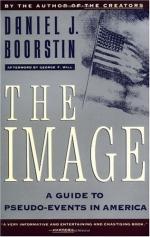|
This section contains 510 words (approx. 2 pages at 400 words per page) |

|
The Image: A Guide to Pseudo-events in America Summary & Study Guide Description
The Image: A Guide to Pseudo-events in America Summary & Study Guide includes comprehensive information and analysis to help you understand the book. This study guide contains the following sections:
This detailed literature summary also contains Topics for Discussion and a Free Quiz on The Image: A Guide to Pseudo-events in America by Daniel J. Boorstin.
The Image takes a bold look at the political, social, and psychological impacts of "pseudo-events", or those events that create a false sense of reality. Daniel Boorstin examines how these events originated in and have been shaped by the media as well as the specific cultural dynamics of America.
Boorstin asserts America's cultural expectations of the world including "what the world holds" and "our power to shape the world" underlies the propensity to develop pseudo-events, which create even grander expectations. Boorstin continues by claiming the media has played a large role in the creation of pseudo-events. He describes the various aspects of pseudo-events and how they function. He concludes the first chapter by exploring the use of pseudo-events in politics, including Joseph McCarthy's use of morning press conferences to announce an afternoon press conference.
In the next section, Boorstin analyzes pseudo-events at the individual level. In particular, he posits that the shift from heroic figures that have actually accomplished great works to a focus on celebrity figures represents a "human pseudo-event". He discusses the impact of science on our perceptions of old heroic figures and the historical impact of totalitarian dictators on perceptions of leaders. The culture has lost the sanctity and transformative power of its leaders and heroes. Boorstin suggests that our new heroes, celebrities, act as reflections of ourselves and are thus unable to "extend our horizon".
Pseudo-events are then carried into the realm of travel. Boorstin asserts that people have changed from "travelers to tourists". Travelers to the Orient helped to pave the way for the Enlightenment through exposure to other ways of being, thinking, and perceiving. In the modern age, tourists "expect both more strangeness and more familiarity than the world naturally offers". Travel has become a kind of "commodity", and it thus it has become more of an experience and less of an activity. In a sense it is more like watching a movie of the jungle than actually being in the jungle.
Boorstin discusses pseudo-events in the context of art and literature. He suggests that the movement towards making art accessible and understandable turned it into a commodity. Boorstin describes this process as "disembodying". This made contact with the felt experience of art and literature more remote. He continues that the "search for the essence" was favored over form.
Following the cultural belief that the world can be formed to our desire, Boorstin extends his thesis and states that people also determine what is ideal. He suggests that this belief allows for God to be made into a pseudo-event. The ideal thus formed allows for the creation of an image which is a kind of publicly sanctioned ideal. The problem is that the image does not necessarily correlate to the reality of what it is supposed to portray. Boorstin then concludes with an examination into the "self-deceiving magic of prestige". He suggests that the "American Dream" is in danger of becoming an illusion. Boorstin asserts that "problems" overseas are really about our inability to "project" our dreams into those countries.
Read more from the Study Guide
|
This section contains 510 words (approx. 2 pages at 400 words per page) |

|



